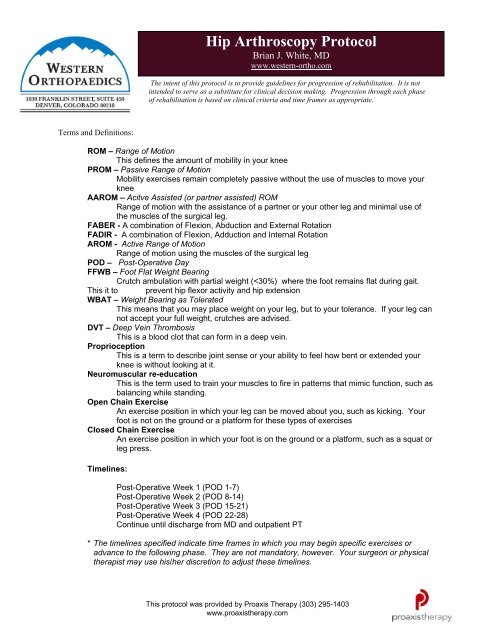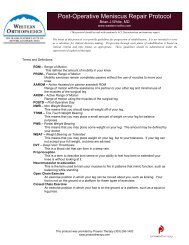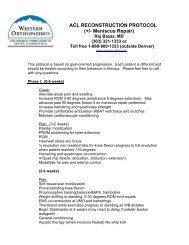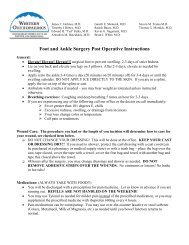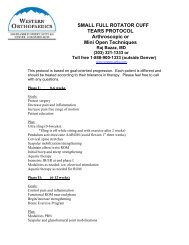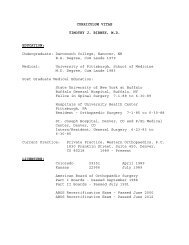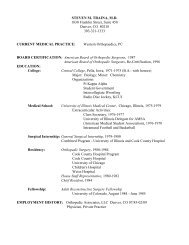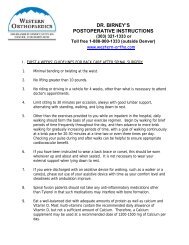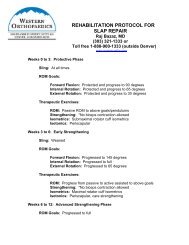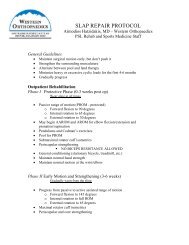Hip Arthroscopy Protocol
Hip Arthroscopy Protocol
Hip Arthroscopy Protocol
You also want an ePaper? Increase the reach of your titles
YUMPU automatically turns print PDFs into web optimized ePapers that Google loves.
<strong>Hip</strong> <strong>Arthroscopy</strong> <strong>Protocol</strong>Brian J. White, MDwww.western-ortho.comThe intent of this protocol is to provide guidelines for progression of rehabilitation. It is notintended to serve as a substitute for clinical decision making. Progression through each phaseof rehabilitation is based on clinical criteria and time frames as appropriate.Terms and Definitions:ROM – Range of MotionThis defines the amount of mobility in your kneePROM – Passive Range of MotionMobility exercises remain completely passive without the use of muscles to move yourkneeAAROM – Acitve Assisted (or partner assisted) ROMRange of motion with the assistance of a partner or your other leg and minimal use ofthe muscles of the surgical leg.FABER - A combination of Flexion, Abduction and External RotationFADIR - A combination of Flexion, Adduction and Internal RotationAROM - Active Range of MotionRange of motion using the muscles of the surgical legPOD – Post-Operative DayFFWB – Foot Flat Weight BearingCrutch ambulation with partial weight (
Initial PrecautionsWeight Bearing:• Foot Flat Weight Bearing (FFWB) for 2 weeks• Microfracture procedures will remain FFWB for 6-8 weeksInitial ROM Restrictions for 2 weeks• Flexion 120º• External Rotation 0º with Flexion at 0º• External Rotation ROM may be done lightly at 90º of hip Flexion by atherapist only• Extension to 0º• Abduction to 45ºOther Restrictions• Only mild hip flexor strengthening to prevent hip flexor tendonitis and/orhypertrophy• CPM• 4-6 hours daily• Microfracture techniques will require use of CPM for 6-8 weeks for 8hours per day.• Bledsoe brace for 2 weeks• Avoid impinging with flexion and FADIR ROM exercises• No Treadmill WalkingPhase 1 - Protection Phase (post-op weeks 1-4)with Microfracture - post-op weeks 1-9Goals:• Reduce swelling and pain• Restore mobility within limitations• Restore patellar mobility• Restore normal gait within limits set by surgeon• Promote normal proprioceptive and neuromuscular controlPain and Swelling• PRICE – Protection, Rest, Ice, Compression, Elevation• Use these items together to reduce pain and swelling• At minimum, 5-6 times per day for 20-30 minute sessions• There is no maximum!• Icing is encourage to be done in prone position to allow for mildstretching of the hip flexors• Modalities as indicated - Ultrasound as Electric Stimulation• Ankle Pumps – for swelling and DVT preventionThis protocol was provided by Proaxis Therapy (303) 295-1403www.proaxistherapy.com
Range of Motion• Passive Range of Motiono Partner assisted ROM recommended 2-4 times per day, 20minutes each episodeo Circumduction to be done at 90º and 30º of hip flexion• Manual Therapy as indicated to improve ROM (belt mobilizationrecommended)• Active/Active Assist Rang of Motiono Stationary Bike without resistance 20 minutes per day (Norecumbent biking to avoid hip flexor contractures)• add resistance in week 3o AAROM beginning at week 2o AROM beginning at week 2-3 as tolerated• Hydrotherapyo ROM exercises are permitted when incisions have healed orstitches have been removed (~2weeks)Gait (walking)• Crutches may be indicated for the first 1-3 weeks to keep excessiveload off of the hip and protect healing structures. This will help toreduce swelling and pain. Microfracture procedures must remainFFWB for 6-8 weeks.• Weaning from crutcheso Begin with weight shifting exerciseso Load limited weight on 2 crutcheso Single crutch walking• This will reduce weight on your surgical leg by 25%• Be sure to place the crutch under the opposite armo Walk small distanced in home without crutches and takecrutches with you for longer distances• Gait Exercises to promote normalized hip extension and lumbarstabilization• Hydrotherapy – water walkingo Walk in water at shoulder levelo Advance to walking at waist levelStrength (weeks 1-3)• Transverse Abdominus/Core isometrics in combination with all otherisometric exercises• Isometricso Quad Sets (avoid SLR’s for 4-6 weeks)o Hamstring Setso Glute setso Ab/Adduction isometricso External and Internal Rotation isometrics• Open Chain Exercises (week 3)This protocol was provided by Proaxis Therapy (303) 295-1403www.proaxistherapy.com
o Prone hip extension exerciseso Glute Medius Exercises (sidelying or standing)o Quad and Hamstring dynamic strengthening in open chainProprioception and Neuromuscular Re-education• Begin open chain proprioception exerciseso prone IR/ER rhythmic stabilization exercise• Light closed chain stability balance exercises (if weight bearing statuspermits)Phase 2 – Initial Strengthening - (Post-Operative weeks 5-8)with Microfracture - Post-Operative weeks 9-13Criteria to advancement to Phase 2• Flexion to 120º• Extension symmetrical to contralateral side• 50% of FABER ROM as compared to contralateral side• 75% of FADIR ROM as compared to contralateral side, withoutimpinging• No hip flexor contractures (otherwise remain in protective phase todecrease hip flexor tone and increase flexibility)• Able to maintain full bridge position without compensations• Mild deviations in gait with mild discomfort onlyGoals• Eliminate Swelling• Full active and passive ROM• Normalize Gait• Increase leg strength to allow for:o Walking 1 mileo Stair ascending/descendingo Double knee bends without compensationso Singe knee bend to 70º without compensationso Resisted Side stepping without painSwelling• Continue PRICE’ing with residual• Modalities as indicated - Ultrasound and Electric StimulationRange of Motiono Motion Specific Stretching to eliminate ROM deficits• Thomas stretchThis protocol was provided by Proaxis Therapy (303) 295-1403www.proaxistherapy.com
• Low Load Duration Stretching for FABER and FADIRposition (while avoiding impingement)• Single Knee to Chest stretches• ITB stretchingo Manual Therapy as indicated for any motion restrictionsStrength• Closed Chain Strength progression (Glutes and Quads)o Leg press with light weight and high repetitionso Mini Squats, 1/3 knee bendso Double knee bends to 90ºo Single Knee Bends – advance to 70 as toleratedo Light plyometrics on shuttle• Abduction Exerciseso Side Steps with thera-bando Lateral Agility Exercise with Sport cord - with and withoutdiagonals• Hamstring Specific Exerciseso Carpet Dragso Hamstring Curlso Physio-ball bridging knee bendsCardioo Bike or spinning with resistanceo Eliptical trainero Swimming as toleratedProprioception, Balance and Neuromuscular Re-education• Begin double leg stability exercises on balance board• Single leg balance on stable/semi unstable (foam) surface• Single leg balance on balance board• Variations of balance exercises with perturbation training• Variations of balance exercises during alternate activity (i.e. balltossing)Phase 3 – Advanced Strengthening (post-operative weeks 10- sport test completion)Criteria for advancement to Phase 3• No residual swelling present• Full Active and Passive ROM• Ascending and Descending stairs with involved leg without pain orcompensation• Gait without deviations or pain after 1 mile of walking on level surface• At least 1 minute of double knee bends without compensationsThis protocol was provided by Proaxis Therapy (303) 295-1403www.proaxistherapy.com
• Single knee bends to 70º flexion without compensationsPersons who do not participate in higher level activities may not need to advance to phase 3. Activitiesthat require advanced strengthening include: running, bounding sports, cutting sports and jumping sports,such as, skiing and snowboarding, golf, basketball, tennis and racquetball, soccer, football and hockey.Goals:• Restore multi-directional strength• Restore ability to absorb impact on leg (plyometric strength)• Pass sport testStrength, Agility, Balance and Stability Training• Increase time on double knee bends with resistance• Increase time on single knee bends. Add resistance as tolerated• Forward backward jog exercises with sport cord• Lateral Agility exercise with diagonals• Jump-land training• Advanced perturbation, balance and stability exercises• Continue with cardio trainingPhase 4 – Return to Sport (passing of sport test – 6 months)Criterion for advancement to phase 4• Pass sport testStrength and Agility• Agility Drills• Chop-Downs• Back Pedals• W-Cuts• Z-Cuts• Cariocas• Cutting Drills• Sport Specific Drills• Adjust Strength and Cardio Regimen to demands of sport• Team Training Progression• Begin training with team at 50% participation level• Advance to 100% participation• Athlete may begin competition at the discretion of surgeonand/or physical therapist• Begin following sports at the discretion of surgeon and/or physicaltherapist• Running• Mountain biking• Golf• Soccer, football, tennis• Skiing and snowboardingThis protocol was provided by Proaxis Therapy (303) 295-1403www.proaxistherapy.com


